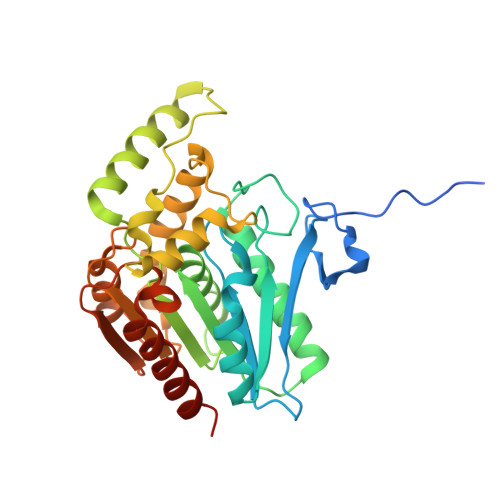Development of a Highly Selective NanoBRET Probe to Assess MAGL Inhibition in Live Cells.
Gazzi, T., Brennecke, B., Olikauskas, V., Hochstrasser, R., Wang, H., Keen Chao, S., Atz, K., Mostinski, Y., Topp, A., Heer, D., Kaufmann, I., Ritter, M., Gobbi, L., Hornsperger, B., Wagner, B., Richter, H., O'Hara, F., Wittwer, M.B., Jul Hansen, D., Collin, L., Kuhn, B., Benz, J., Grether, U., Nazare, M.(2025) Chembiochem 26: e202400704-e202400704
- PubMed: 39607084
- DOI: https://doi.org/10.1002/cbic.202400704
- Primary Citation of Related Structures:
9FY5 - PubMed Abstract:
Cell-free enzymatic assays are highly useful tools in early compound profiling due to their robustness and scalability. However, their inadequacy to reflect the complexity of target engagement in a cellular environment may lead to a significantly divergent pharmacology that is eventually observed in cells. The discrepancy that emerges from properties like permeability and unspecific protein binding may largely mislead lead compound selection to undergo further chemical optimization. We report the development of a new intracellular NanoBRET assay to assess MAGL inhibition in live cells. Based on a reverse design approach, a highly potent, reversible preclinical inhibitor was conjugated to the cell-permeable BODIPY590 acceptor fluorophore while retaining its overall balanced properties. An engineered MAGL-nanoluciferase (Nluc) fusion protein provided a suitable donor counterpart for the facile interrogation of intracellular ligand activity. Validation of assay conditions using a selection of known MAGL inhibitors set the stage for the evaluation of over 1'900 MAGL drug candidates derived from our discovery program. This evaluation enabled us to select compounds for further development based not only on target engagement, but also on favorable physicochemical parameters like permeability and protein binding. This study highlights the advantages of cell-based target engagement assays for accelerating compound profiling and progress at the early stages of drug discovery programs.
Organizational Affiliation:
Leibniz-Forschungsinstitut für Molekulare Pharmakologie, Berlin, Germany.


















